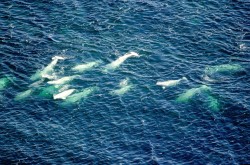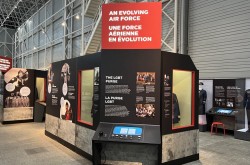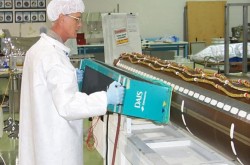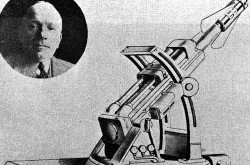Adventures in Virtual Field Trips: "Check that camera angle, please!"

Around the world, educational programs have had to change — and fast — in response to the global pandemic. This left many educators scrambling to alter established programming, and to set up technology tools for virtual learning.
Kim Reynolds is the Education and Interpretation Officer at the Canada Aviation and Space Museum in Ottawa. A seasoned educator with a bubbly personality and a contagious laugh, Reynolds is a key player in developing the museum’s Virtual Field Trips. In a light-hearted new series for the Ingenium Channel, she shares some of the lessons she’s learned along the way — in an effort to lend a helping hand to educators everywhere.
Back in January 2021, I was sitting at home — connected to work by Zoom (or was it Google Meet that day?) in order to train a couple of our fabulous guides from the Canada Aviation and Space Museum on our new Virtual Field Trips. Let’s call them Arthur and Meghan (not their real names!).
We were in the midst of another COVID-related lockdown for our area, but guides were deemed essential and were allowed in the classrooms — under a strict series of controls — for the training and delivery of our educational programs.
Arthur was setting up some of the experiments we planned to do with kids, while Meghan did a mic check. Suddenly, I realized that in addition to being an educator and a trainer, I was now a director!
Full disclosure: Directing is not my field of expertise. I watch a fair bit of television, and who doesn’t pretend like they could have done better after watching a real catastrophe of a production? It’s easy to be an armchair anything! I am an actor and a musician, but I’ve never fancied myself behind the camera. When I’m on set, I stand where I’m told, I move when I’m told, and I try very hard not to get hit in the head with anything…else (long story for another article!).
But there I was, watching the set up, when I realized that something had to be said…and as the honorary director, it was my job to do the saying.
“No crotch shots, please!” bellows my inner Stephen Spielberg.
But I didn’t utter those words aloud…yet. Instead, my brain went off on a tangent something like this:
Kim’s brain: Would Stephen Spielberg say that? What about George Lucas? Or would they even need to say that because surely there are camera people to figure these things out? Oh hey, which camera-related job actually decides what the shot looks like? Or, really wouldn’t have they have mapped the shot out before….
Oh right…I still need to say something to this colleague…
[Unmutes Mic]
Kim: “Hey Arthur, if you want the group to see your face, you could sit down behind the aquarium on the table.”
Kim’s brain: Oh that was good. Very crafty. Avoid the situation altogether, save everyone a little embarrassment. Nice one.
Arthur: “Um…actually I’d prefer to be standing, because it would be really hard for me to reach into the aquarium with the right angle if I’m sitting. I also need to be able to see the laptop so I can adjust settings, and see the chat in case there are questions…”
Kim’s brain: Drat. Outplayed.
Kim: “Okay, got it.” [Mutes Mic. Come on, brain you can do this…think!]
Kim: [Unmutes Mic] “Hey Arthur, so the thing is that with the aquarium on the table, and it being see through and all, you’ll need to be conscious of where the camera is pointing…. and everything that is in view?”
[Mutes Mic and hopes for the best.]
Arthur: …
Kim’s brain: Oh come on; we’re all grown-ups… Yes, but I don’t want to embarrass anyone… Yes, but it will be more embarrassing later… this is a serious broccoli-in-the-teeth-moment and you’ve got to step up! [Unmutes Mic]
Kim: “So…what I mean is, basically, no crotch shots please.”
Arthur: “Oh yes!” [Immediately adjusts camera to a different angle]
[Pause for a wee bit of semi-nervous giggling on all sides]
Meghan: “So Kim, when we’re doing this in Zoom, everything is fine. But in Google Meet, we can’t see ourselves and the kids and the Powerpoint at the same time. Do you know how to fix that?”
Kim’s brain: Okay, next hat…tech guru! [Unmutes Mic]
Kim: “Okay, we figured this one out the other day when I was training Alice and Gary. Let’s hop on over to Google Meet and I’ll walk you through it. I’ll send you the link in a moment!”
Kim’s brain: You do remember how to do that, don’t you? Umm, yeah… somewhere in here… c’mon brain… so what if you’re almost 50 and you remember life before computers. You got this! 50 is the new 30, right? You can do this!
[End Scene]

The scene of a guide training session for the Canada Aviation and Space Museum's virtual programming.
So why did I write this amusing anecdote? First of all, I hope it made you smile! Beyond that, I wanted to share what this experience taught me.
For starters, I learned that when you take a school program that you usually deliver live and decide to deliver it over video, you really do have to start thinking like you’re producing a TV show. Where previously, a group could be instructed to stand or sit in a particular location to best view the guide — and where those individuals have some autonomy to arrange themselves to see things — now we have to consider our audience and try to arrange things so that they will have the best view. No amount of them moving their laptop will give them a better vantage point on our experiments!
And sure, I learned a lot about Zoom and Google Meet…as well as generating links, pinning speakers, and how to make your Powerpoint take up the whole screen. But most of all, I learned that the strongest bond is our humanity. It is okay to be human — to have good days and bad, to be stressed, to laugh, to make mistakes, and to ask for help.
In a world where it is common for people to wear metaphorical masks — especially at work — we are at our strongest when we remove those masks (even while we wear our literal ones!) and work together as our beautiful, human selves.
In the next article in the “Adventures in Virtual Field Trips” series, Kim Reynolds introduces us to two amazing museum guides who helped convert a popular educational program into virtual format.
Enjoying the Ingenium Channel? Help us improve your experience with a short survey!








![A block of photographs showing some of the people involved in the bombing of beluga whales in the estuary and gulf of the St. Lawrence River. Anon., “La chasse aux marsouins [sic]. » Le Devoir, 15 August 1929, 6.](/sites/default/files/styles/thumbnail_7/public/2024-09/Le%20Devoir%2015%20aout%201929%20page%206.jpg?h=584f1d27&itok=TppdLItg)






